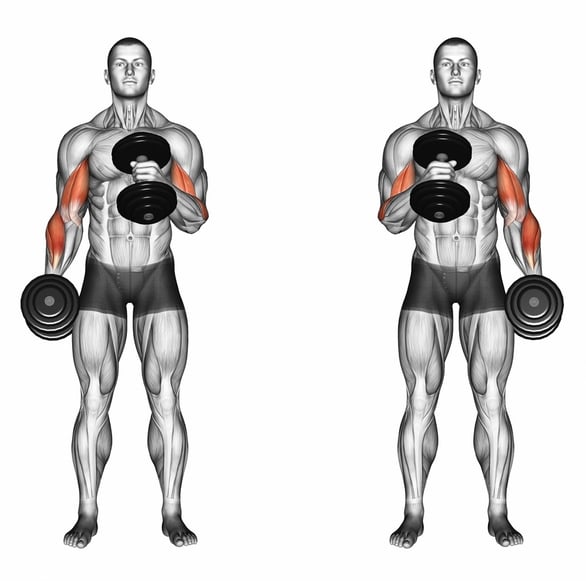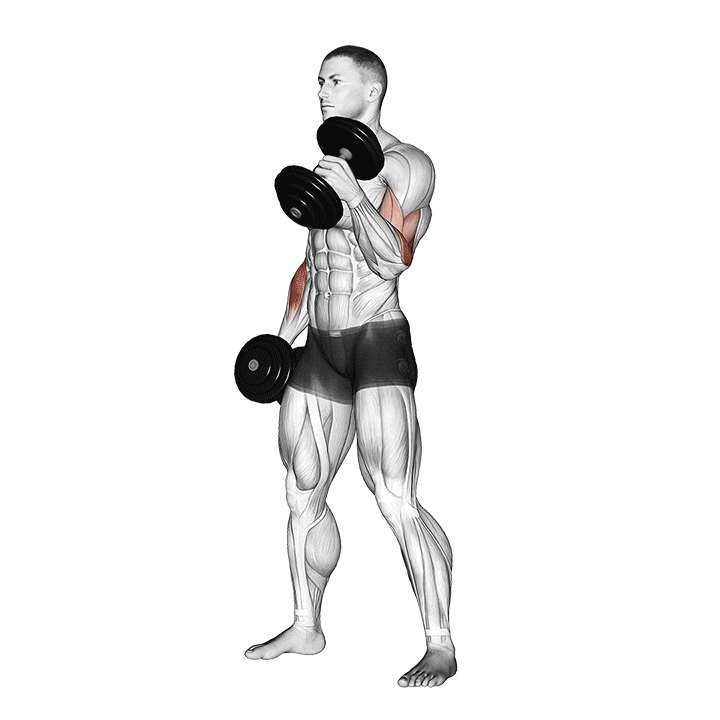Hammer Curl Exercise: A Complete Guide to Targeting the Brachialis and Forearms
ARMS
Admin
9/24/20244 min read
If you want bigger arms and stronger forearms, then adding Hammer Curls to your workout routine is a must. This exercise targets the often-overlooked brachialis muscle and improves forearm strength, giving your arms a fuller, more defined look. In this guide, you'll discover everything you need to know about Hammer Curls, from the muscles worked to proper technique, variations, and how to program them for the best results.


Table of Contents
1. What is the Hammer Curl?
The Hammer Curl is an effective arm exercise that targets the brachialis, which lies underneath the biceps, as well as the forearm muscles. The exercise involves lifting dumbbells with a neutral grip (palms facing each other) to strengthen both the upper and lower arms.
Unlike traditional bicep curls, hammer curls focus on building thickness and enhancing forearm strength, making it a crucial move for overall arm development.
2. Muscles Worked in Hammer Curls
The Hammer Curl primarily works the following muscles:
Brachialis: This muscle is located beneath the biceps and plays a key role in adding thickness to your arms.
Brachioradialis: The main forearm muscle engaged during this exercise.
Biceps brachii: Although not the primary focus, the biceps assist in the movement.
Forearm flexors: These muscles stabilize the wrist and forearm during the lift, improving grip strength.
The Hammer Curl provides a comprehensive workout for your arms, especially when combined with other bicep exercises.
3. Benefits of Hammer Curls
Including Hammer Curls in your workout routine offers several advantages:
1. Increased Arm Thickness
Hammer curls target the brachialis, a crucial muscle for arm thickness. This results in a fuller, more defined look, especially when viewed from the side.
2. Improved Forearm Strength
Because this exercise activates the brachioradialis and forearm flexors, it enhances grip strength and forearm endurance. This is useful for other exercises like deadlifts and pull-ups.
3. Balanced Arm Development
Regular curls primarily target the biceps, but hammer curls focus on often-neglected muscles like the brachialis and forearms, promoting balanced arm development.
4. Reduced Risk of Elbow Injuries
Stronger forearms and a developed brachialis can help stabilize the elbow joint, reducing the risk of overuse injuries.
4. How to Perform Hammer Curls with Proper Form
Mastering the proper form is essential for reaping the full benefits of Hammer Curls while avoiding injury. Here's how to do them right.
Step-by-Step Guide
Starting Position
Stand upright with feet shoulder-width apart, holding dumbbells at your sides with a neutral grip (palms facing each other).
Keep your elbows close to your torso, and engage your core for stability.
Curl the Dumbbells
Keeping your upper arms stationary, curl the dumbbells towards your shoulders.
Squeeze the brachialis and forearms as you reach the top of the movement.
Pause and Squeeze
At the top, pause and squeeze your muscles for maximum engagement. Avoid moving your wrists or elbows during the lift.
Lower Slowly
Lower the weights back to the starting position, maintaining control throughout the descent.
Key Tips for Better Results
Avoid momentum: Don’t swing the weights; keep the motion slow and controlled.
Focus on the neutral grip: This is key for engaging the correct muscles.
Keep your back straight: Avoid arching your back during the curl.


5. Common Hammer Curl Mistakes to Avoid
Like many exercises, the Hammer Curl can be performed incorrectly if you're not mindful of your form. Here are common mistakes to watch for:
1. Using Excessive Weight
Choosing a weight that’s too heavy often leads to using momentum or engaging other muscles to lift the dumbbells. Always select a weight that allows for controlled reps.
2. Swinging the Dumbbells
This reduces tension on the muscles and may lead to injuries. Perform slow and controlled movements for the best results.
3. Limited Range of Motion
Ensure you complete the full range of motion by fully extending your arms at the bottom and bringing the weights up to shoulder level.
6. Hammer Curl Variations to Build Bigger Arms
To keep your training interesting and continuously challenge your muscles, try these hammer curl variations:
1. Cross-Body Hammer Curl
This variation involves lifting the dumbbells across your body toward the opposite shoulder. It puts more emphasis on the brachialis and forearm muscles, leading to even better arm thickness.
2. Rope Hammer Curl (Cable Machine)
Performing hammer curls with a rope attachment on a cable machine provides constant tension throughout the movement, which increases muscle activation and builds endurance.
3. Seated Hammer Curl
By sitting down, you eliminate any ability to use momentum, making the exercise more isolated and intense.
7. Recommended Sets, Reps, and Rest
To build size and strength in your arms, consider the following set and rep guidelines:
For muscle growth: 3-4 sets of 8-12 reps.
For strength: 3 sets of 6-8 reps, with slightly heavier weight.
Rest for 45-60 seconds between sets for hypertrophy, or up to 2 minutes for strength-focused training.
8. How to Add Hammer Curls to Your Arm Workout
The Hammer Curl fits perfectly into any arm routine. You can add it alongside traditional bicep exercises or pair it with tricep movements for a balanced arm workout. Here’s a sample arm workout that includes hammer curls:
Barbell Curl – 4 sets x 8 reps
Hammer Curl – 4 sets x 10-12 reps
Preacher Curl – 3 sets x 12 reps
Triceps Dips – 4 sets x 8 reps
This routine ensures your biceps, brachialis, and forearms are thoroughly worked, providing a well-rounded arm workout.
9. FAQs About Hammer Curls
Q: Are Hammer Curls better than regular bicep curls?
A: Both exercises have their place in a well-rounded workout. Hammer curls focus more on the brachialis and forearms, while regular curls emphasize the biceps.
Q: Can I do hammer curls every day?
A: It’s best to allow at least 48 hours between arm workouts to give your muscles time to recover and grow.
Q: Do hammer curls work the forearms?
A: Yes, hammer curls are great for building forearm strength, as they activate the brachioradialis and forearm flexors.
11. References
Fitness Education
Schoenfeld, B. J. (2010). Squat vs. Leg Press: A Meta-Analysis. Journal of Strength and Conditioning Research, 24(12), 3397-3401.
Peterson, M. D., & Gordon, P. M. (2011). Resistance Exercise for Muscular Strength in Older Adults: A Meta-Analysis. Journal of Aging and Physical Activity, 19(1), 56-67.
Fitness
Expert tips for your fitness journey await you.
Nutrition
Wellness
+919316200784
© 2024. All rights reserved.
Write your text here...
2. Which is Better: Barbell or Dumbbell Bicep Curls?
Both barbell and dumbbell bicep curls are effective. Barbell curls allow for lifting heavier weights and provide balanced resistance, while dumbbell curls offer more flexibility and help correct muscle imbalances.
